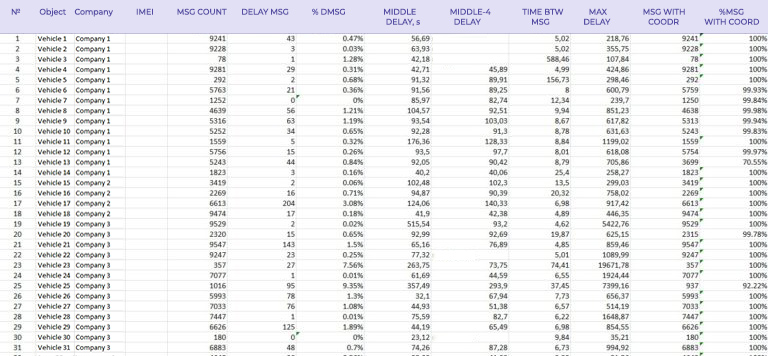In the process of aggregating telematic data from different carriers, it often turns out that data from subscriber terminals enter the system with different delays and quality. The reason is that each carrier uses different telematics equipment. In addition, user terminals transmitting data to the system may be configured differently. For example, a carrier saves subscriber traffic and configures its equipment to send messages less than 1 time 60 seconds.
In addition, sometimes the quality of transmitted data is deliberately reduced. For example, unscrupulous drivers can jam GSM and GPS signals, which leads to the sending of outdated data or data without GPS coordinates.
On the other hand, large Customers who monitor the telemetry of the movement of hired vehicles often have requirements for the frequency and quality of incoming telematic data. For example, data collected from multiple carriers may be aggregated on a server for processing and transmission to a WMS system. The main requirement of such systems is the quality of incoming data for delays and the presence of GPS coordinates. If the incoming data does not meet the specified conditions, the WMS system will not work correctly.
Requirements
Since there are a lot of monitoring objects, it is difficult to manually check and evaluate the quality of incoming data from each object.
Our solution
To solve this problem, Geoservice engineers have developed their own tool for checking and evaluating the quality of telematic data.
A special processor analyzes the flow of incoming data from each device, and evaluates it according to the following metrics:
- Messages with a delay (> 300 sec),
- % of messages with a delay (> 300 sec) of the total number
- Average message delay,
- Average delay of messages with speed (> 4 km/h),
- Average time between messages,
- Max. delay,
- Messages with coordinates,
- % of messages with coordinates from the total number.

The result of the assessment is a summary report on all monitored objects. The data for each object is analyzed for its relevance, delays and availability of coordinates.
Based on this report, the Customer can make reasonable demands to carrier companies, forcing them to set up equipment properly and provide quality data to the WMS system.
Example:
The customer is a large metallurgical plant in the European part of Russia. About 20 carrier companies, each carrier uses its own monitoring system.
Task:
Aggregation of telematics data from different monitoring devices on a single information platform and to sending collected data to the AXELOT logistics platform with the following criteria:
- Data must be received without delay at least once every 60 seconds.
- Providing Customer with the quality report of incoming data, on the basis of which the Customer makes requirements to the contractors.
Decision:
- Combine data from different systems in a single information platform.
- Develop algorithms and logic for data processing.
- Analyze the received data for the relevance, sending messages delays and coordinates presence.
- Provide the processed data to the Customer in the AXELOT logistics platform.
- Provide the Customer with the quality report of incoming data.
Result:
- The Customer receives consolidated data from hundreds of objects without delay.
- The Customer receives the quality reports of incoming data.
- Data is transmitted to the Customer’s system online and processed in real time.